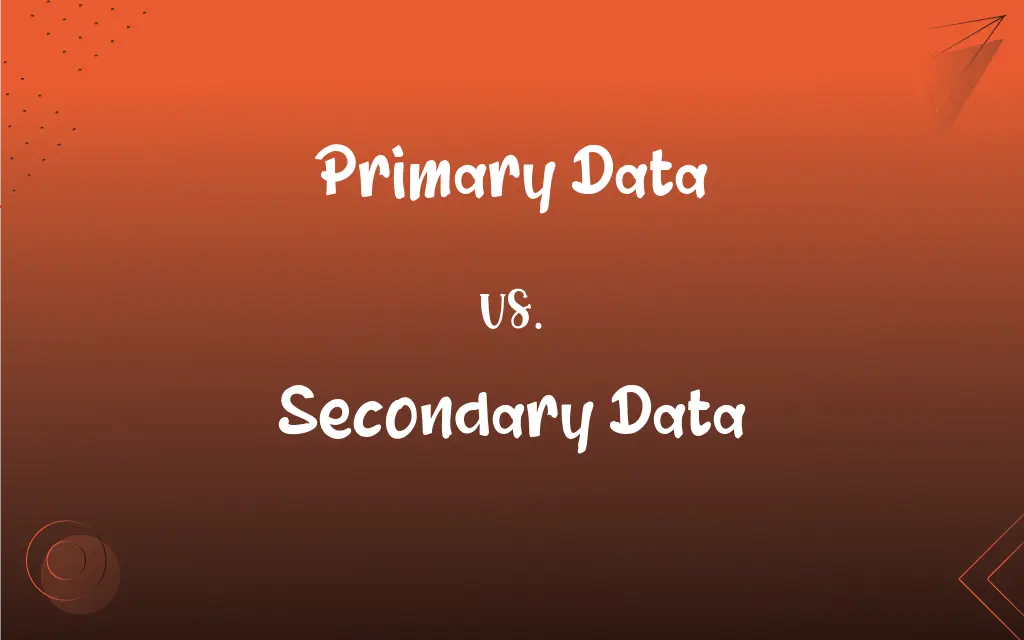Primary Data vs. Secondary Data: What's the Difference?
Edited by Janet White || By Harlon Moss || Updated on October 17, 2023
Primary data is collected firsthand for a specific purpose, while secondary data is previously collected and used for another purpose.

Key Differences
Primary data refers to information collected directly by the researcher for a particular study or project. Secondary data, on the other hand, is data that has already been collected and processed by someone else for a different objective.
When relying on primary data, a researcher often gathers it through methods like surveys, observations, or experiments. Secondary data is typically accessed from existing sources like published articles, government reports, or databases.
The main advantage of primary data is its relevancy to the specific study at hand, ensuring it meets the precise needs of the researcher. Secondary data's strength lies in its availability and cost-effectiveness since it has already been compiled.
Primary data generally offers more control over the quality and methodology of data collection. In contrast, secondary data might have limitations in its applicability since it was gathered with different research questions in mind.
Using primary data can be time-consuming and often more expensive because it involves direct data collection. Accessing secondary data, however, is usually quicker and less costly but may not be as tailored to the research question.
ADVERTISEMENT
Comparison Chart
Source
Collected directly by the researcher.
Previously collected by another entity.
Purpose
Specific to the current study or project.
Originally for another purpose.
Cost & Time
Often more expensive and time-consuming.
Usually cost-effective and quick to access.
Control
Greater control over quality and methodology.
Limited control; dependent on original source.
Examples
Surveys, experiments, direct observations.
Published reports, databases, previous studies.
ADVERTISEMENT
Primary Data and Secondary Data Definitions
Primary Data
Information gathered firsthand for a specific study.
A company conducting a survey to understand its customers' preferences is collecting primary data.
Secondary Data
Pre-existing data used for a different research question.
An author referencing a historical study in their book is using secondary data.
Primary Data
Original data collected for the first time.
Clinical trials that test a new drug's efficacy generate primary data on its effects.
Secondary Data
Previously published or processed information.
A business using industry reports to understand market trends is leveraging secondary data.
Primary Data
Unprocessed, raw data obtained directly from the source.
Direct observations of a bird species' behavior in the wild yield primary data.
Secondary Data
Information that has been previously collected for another purpose.
Using census data for market research is utilizing secondary data.
Primary Data
Data sourced directly from its origin without any alterations.
Feedback forms filled out by attendees after an event provide primary data about their experience.
Secondary Data
Data obtained from a source other than the original or primary source.
An academic paper citing another study's findings is employing secondary data.
Primary Data
Firsthand information that hasn't been previously published.
A researcher measuring air quality in a city is gathering primary data on pollution levels.
Secondary Data
Data that isn't gathered firsthand by the researcher.
A student writing a thesis and using articles from a library is relying on secondary data.
FAQs
Can primary data be turned into secondary data?
Yes, once primary data is published or used in a different study, it becomes secondary data.
Which data type, primary or secondary, is more reliable?
Both can be reliable; however, primary data offers more control over quality, while secondary data's reliability depends on the original source.
Is primary data always more expensive to obtain?
Generally, yes, as primary data collection can involve extensive research methods, while secondary data is readily available.
What is primary data?
Primary data is information collected firsthand for a specific research purpose.
How does secondary data differ?
Secondary data is previously gathered information, originally collected for another purpose.
Why might a researcher prefer secondary data?
Secondary data can be cost-effective, quickly accessible, and suitable for broader overviews.
What are common sources of secondary data?
Databases, published studies, government reports, and books are typical sources of secondary data.
Do all research projects need primary data?
No, many projects, especially literature reviews or meta-analyses, primarily use secondary data.
Why is primary data seen as more authentic?
Because it's gathered directly from the source, ensuring its relevancy and accuracy for the specific study.
Can secondary data offer broader perspectives?
Often, yes. Secondary data, especially from comprehensive studies, can provide broader overviews than primary data might.
Is data from a focus group considered primary data?
Yes, because it's collected firsthand for a specific research question.
Does primary data offer better specificity?
Typically, yes. Primary data is tailored to a particular research question, ensuring specificity.
What's a challenge with primary data collection?
It can be resource-intensive, requiring time, money, and expertise.
Are there ethical considerations in using secondary data?
Yes, researchers should ensure they have permission to use secondary data and appropriately cite original sources.
What's a limitation of secondary data?
It might not perfectly align with the current research's objectives since it was collected for a different purpose.
Can secondary data inform primary data collection?
Absolutely, researchers often use secondary data to guide or complement primary data collection methods.
Can the same dataset be both primary and secondary data?
Yes, depending on its use. If reused in a different study, primary data can function as secondary data.
Is referencing a study's results in a report using secondary data?
Yes, you're using data previously collected by someone else, making it secondary data.
Which is faster to collect: primary or secondary data?
Typically, secondary data is faster to access since it's already been collected.
Is using a newspaper archive considered using primary or secondary data?
It's secondary data, as the information wasn't collected firsthand for your specific research.
About Author
Written by
Harlon MossHarlon is a seasoned quality moderator and accomplished content writer for Difference Wiki. An alumnus of the prestigious University of California, he earned his degree in Computer Science. Leveraging his academic background, Harlon brings a meticulous and informed perspective to his work, ensuring content accuracy and excellence.
Edited by
Janet WhiteJanet White has been an esteemed writer and blogger for Difference Wiki. Holding a Master's degree in Science and Medical Journalism from the prestigious Boston University, she has consistently demonstrated her expertise and passion for her field. When she's not immersed in her work, Janet relishes her time exercising, delving into a good book, and cherishing moments with friends and family.































































